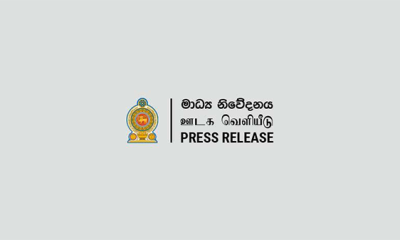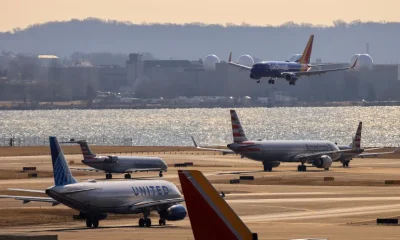News
Presidential committee critical of response to ‘protest movement’
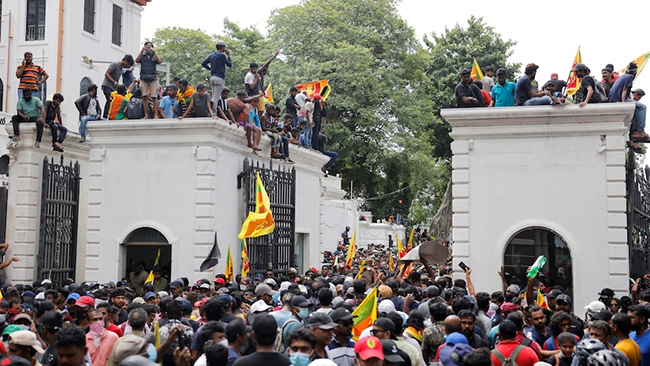
Security measures alone insufficient to meet toxic combination of economic-political-social crises
By Shamindra Ferdinando
A three-member committee that probed the failure on the part of the then government to quell the May 09 incidents was planning to hand over its report to President Gotabaya Rajapaksa when he was forced to flee the country on 13 July.The committee consisted of Admiral of the Fleet (ret.) Wasantha Karannagoda (Chairman), Marshal of the Air Force (ret.) Roshan Gunatilleke and General (ret.) Daya Ratnayake.
Well informed sources told The Island that the committee had handed over an interim report that dealt with three or four critical points/issues to the then President Rajapaksa.
Sources said that even after the eruption of violent protests at the private residence of President Gotabaya Rajapaksa at Pangiriwatta, Mirihana, on the night of 31 March, the growing threat appeared to have been largely ignored.President Gotabaya Rajapaksa moved to the President’s House in the first week of April.
The Chief of Defence Staff (CDS) Service commanders, the IGP and several officers, at different levels, appeared before the committee at the Office of the Governor of the Western Province, Marshal of Air Force Roshan Gunatilleke. The committee examined the ease with which goons targeted the properties of some ruling party politicians in the aftermath of an attack the supporters of the then Prime Minister Mahinda Rajapaksa carried out on the Galle Face protesters on 09 May.
Karannagoda and Ratnayake served as the Governor of the North Western Province and Secretary to the Trade Ministry, respectively, at the time of the high-profile investigation. The committee questioned the security setup that was overwhelmed by the protest movement.
Sources acknowledged that the rapid developments that threatened the entire government set-up couldn’t have been tackled by security measures alone. The rapidity with which the protest movement grew had made it quite impossible to de-escalate the threat by security measures alone, senior officials involved with the evacuation of the then President said. Sources said that the toxic combination of political- economic-social crisis simply overwhelmed the government.
Just over a week before the July 09 attack on the President’s House, the then President Gotabaya Rajapaksa promoted Army Chief of Staff Maj. Gen. Vikum Liyanage to the rank of Lt. Gen. and appointed him Commander of the Army.Although the government was aware that the protesters were planning to take over the President’s House on 09 July, the police and the armed forces had been ordered to protect the place without shooting.Once the defences at Chatham Street collapsed the military brass asked the President to vacate the President’s House.
Among those present at that time were Defence Secretary General Kamal Gunaratne, who was re-appointed by newly elected President Ranil Wickremesinghe, Air Force Commander Air Marshal Sudarshana Pathirana, Navy Chief Vice Admiral Nishantha Ulugutenna, IGP C.D. Wickremaratne and State Intelligence Service Chief Maj. Gen. Suresh Sally.
CDS General Shavendra Silva was in Kochi, India, to attend the 6th Deputy National Security Advisor Level Meeting of the Colombo Security Conclave. Having led the government delegation at the Kochin conference (July 6-9), by the time Gen. Silva returned around 12. 20 pm 09 July, the President and first lady Iyoma Rajapaksa had been moved to the nearby Navy base where preparations were underway for them to board SLNS Gajabahu.
What really saved the day was their ability to take a route from the President’s House without attracting the attention of the protesters. Contrary to reports, the first couple had been under naval protection on the ground for some time before they boarded SLNS Gajabahu formerly of the US Coast Guard. Sri Lanka commissioned the High Endurance Cutter in June, 2019, at an event attended by the then President Maithripala Sirisena and US Ambassador Teplitz.
The Navy headquarters politely declined to disclose the time the vessel departed the Colombo port or arrived at the Trincomalee harbour. However, sources said that the vessel docked at around 10 am on July 10 in Trincomalee, where the first couple stayed the night. On the following day, the first couple flew to Katunayake air base from Trincomalee via Ratmalana.
The security forces top brass had discussed rapidly changing developments with the President at the Katunayake air base before the CDS flanked by service commanders appealed for calm at a hastily arranged media briefing.In spite of the President personally requesting Sri Lankan Airlines Chairman Asoka Pathirage to make arrangements for him, his wife and bodyguards to leave on a SriLankan flight, the Rajapaksa appointee has explained his inability to assist. They hadn’t been able to secure seats on the Etihad flight and finally flew on AN 32, one of the precious transport aircraft belonging to the SLAF.Sources asserted that had there been a proper and realistic assessment of the public resentment towards the powers that be the President wouldn’t have stayed at the President’s House till almost noon on July 09.
News
34 new projects under “Clean Sri Lanka” programme this year
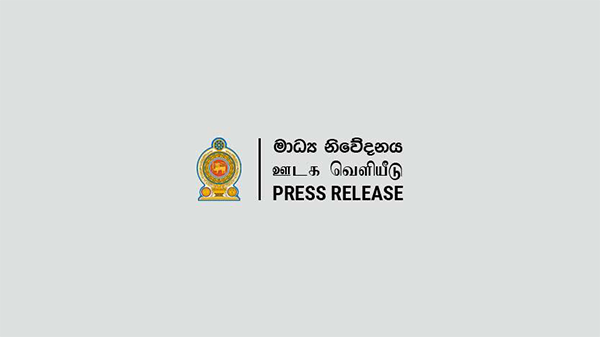
Under the guidance of President Anura Kumara Disanayake, the “Clean Sri Lanka” programme, implemented as a key government initiative is set to launch 34 new projects this year, and work on many of these projects is scheduled to commence by the end of this April.
In line with this, a one-day workshop was held on Thursday (10) at the “Clean Sri Lanka” Secretariat located in the Lotus Building at the Temple Trees, under the leadership of Secretary to the President Dr. Nandika Sanath Kumanayake. The workshop provided technical guidance on preparing project proposals in accordance with the formats required by the Department of National Planning for submission and approval.
The “Clean Sri Lanka” programme aims to foster social, environmental and ethical transformation across the country, with the active participation of all stakeholders. A sum of Rs. 5 billion has been allocated from this year’s national budget for its implementation.
Once the Department of National Planning grants approval for the proposed projects, detailed action plans will be developed in line with prescribed formats. It was agreed that projects deemed ready for implementation will commence before the end of April.
During the workshop, Secretary to the President outlined the government’s expectations and the intended outcomes of the “Clean Sri Lanka” programme.
Senior officials representing the Ministry of Public Administration, Provincial Councils and Local Government, Ministry of Foreign Affairs, Foreign Employment and Tourism, Ministry of Health and Mass Media, Ministry of Education, Higher Education and Vocational Education, Ministry of Transport, Highways, Ports and Civil Aviation, Ministry of Public Security and Parliamentary Affairs, Ministry of Agriculture, Livestock, Lands and Irrigation, Ministry of Digital Economy, Ministry of Urban Development, Construction and Housing, Ministry of Environment, Ministry of Industries and Entrepreneurship Development, Sri Lanka Police, and the Western Provincial Council were in attendance.
Also present were Engineer S.P.C. Sugeeshwara, Additional Secretary to the President (Clean Sri Lanka Programme) and G.M.R.D. Aponsu, Senior Additional Secretary to the President (Finance and Economic Affairs), along with other senior officials.
[PMD]
News
Financial assistance of USD 01 Million for the Disaster-Affected People of Myanmar
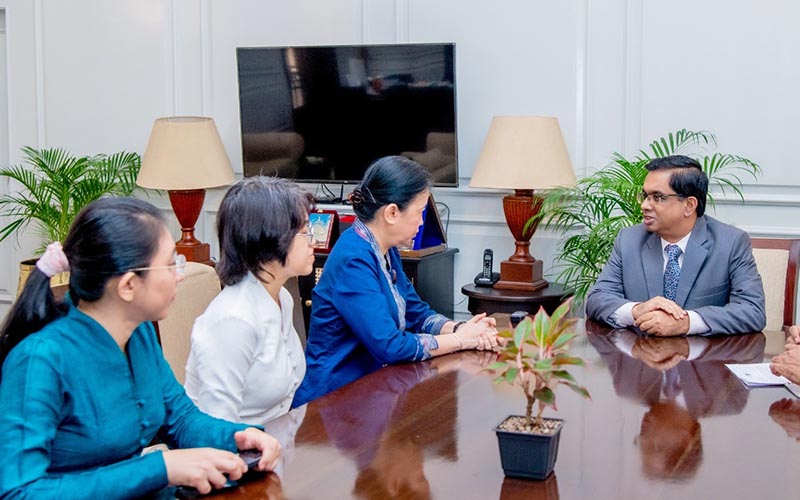
The Government of Sri Lanka has extended financial assistance amounting to USD 01 Million to provide relief to the people of Myanmar affected by the recent earthquake.
The relevant cheque was officially handed over by the Secretary to the President, Dr. Nandika Sanath Kumanayake, to the Ambassador of Myanmar to Sri Lanka, Marlar Than Htaik.on Thursday (10) at the Presidential Secretariat.
Despite the prevailing economic challenges in Sri Lanka, the Ambassador of Myanmar expressed her deep appreciation to President Anura Kumara Disanayake and the Government of Sri Lanka for this gesture of solidarity and support towards the disaster-stricken people of Myanmar.
Furthermore, the Ambassador extended her gratitude for Sri Lanka’s decision to deploy relief teams and medical personnel during this difficult time. She also noted that such acts of compassion further strengthen the longstanding religious and cultural friendship between Sri Lanka and Myanmar.
The Ambassador also briefed the Secretary to the President on the current situation in Myanmar following the earthquake.
Senior Additional Secretary to the President, Roshan Gamage, along with officials from the Embassy of Myanmar, Winh Wint Khaus Tun and Ms. Lei Yi Win, were also present at this occasion.
[PMD]
News
Indo-Lanka MoUs unlikely to be tabled in Parliament any time soon
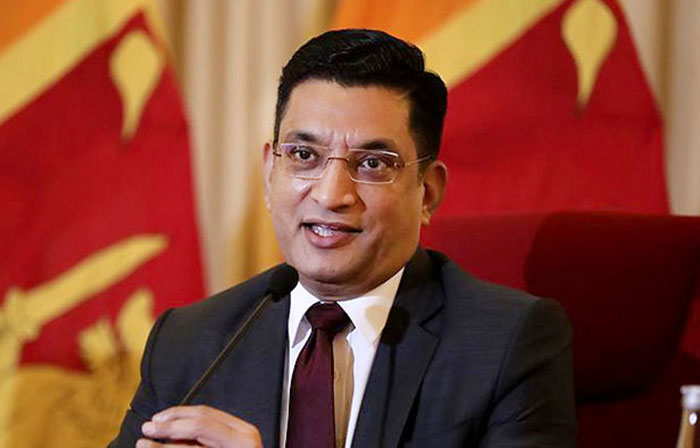
…of seven SOCs only one constituted so far
Sri Lanka’s controversial MoU on Defence Cooperation with India was unlikely to be taken up any time soon in Parliament in spite of the House Sectoral Oversight Committee (SOC) on Governance, Justice and Civil Protection that has been assigned defence, authoritative sources told The Island.
Of the seven SOCs only one was activated with the recent election of Dr. Najith Indika, MP, as the Chairman of the Sectoral Oversight Committee on Governance, Justice, and Civil Protection of the Tenth Parliament.
The inaugural meeting of the current parliament was held on 21 Nov., 2024.
Sources said that the parliament had met for the last time yesterday (10) before the Sinhala and Tamil New Year holiday. It is scheduled to meet again on May 8.
The UNDP that has financially backed the establishment of the SOC system to help strengthen the role of the parliament recently reached a consensus with the government to reduce the number of SCOCs from 17 to seven. The Island, in writing, asked for the UNDP’s reaction to the operation of SOCs but had not received a response at the time this edition went to press.
The SOCs have the power to examine any Bill, except the Bills defined in Article 152 of the Constitution, Treaty, Reports including the Annual and Performance Reports relating to the institutions coming under its purview or any other matter referred to the Committee by Parliament or any Committee or a Minister relating to the subjects and functions within their jurisdiction.
Sources said that out of the seven SOCs only one had been activated during the past five months though the government and the Opposition agreed to share the leadership of them.
Accordingly, it was agreed that the government would appoint chairpersons to four SOCs –– Economic Development and International Relations, Health, Media and Women’s Empowerment, Science, Technology and Digital Transformation and Governance, Justice and Civil Protection .
It was also agreed that the Opposition would appoint chairpersons to the SOCs on Infrastructure and Strategic Development, Education, Manpower and Human Capital, and Environment, Agriculture and Resource Sustainability to the Opposition.
India and Sri Lanka on April 5 signed six MoUs on HVDC interconnection for import/export of power, cooperation in the field of sharing successful digital solutions implemented at population scale for digital transformation, defence cooperation, multi sectoral grant assistance for Eastern province, health and medicine and pharmacopoeia cooperation. In addition to them, India, Sri Lanka and UAE signed a tripartite MoU cooperation in development of Trincomalee as an energy hub.
The Island asked Ali Sabry, PC, who served as foreign minister during Ranil Wickremesinghe’s tenure as the President (July 2022 to Sept 2024) whether the seven MoUs had been discussed during that period. We also asked him whether those MoUs should have been discussed at SOCs before finalisation.
Sabry said: “Most of the MOU to my knowledge were discussed except the one on Defence Cooperation, which I am unaware of. General procedure is the relevant line ministry prepares the initial draft and gets the input from the Foreign Ministry and goes for stakeholder consultation of all ministries and agencies involved. Then the President’s Office grants its sanction and with the approval of the AG, it goes before the cabinet of ministers. With Cabinet approval, the government could sign the MOU.”
Sabry said that he was of the opinion that once the government signed a particular MoU, it should be placed before the parliament. “MOU’s are generally not legally binding and only signify the desire to work together. If the signed MoUs were to be implemented, then they have to be followed by agreements or laws.”
He emphasised the pivotal importance of transparency in the whole process. The ex-minister said: “I think transparency is crucial in these matters. Concealment leads to speculation and assumption of the worst. The MOUs should be tabled in Parliament for public information. Discussion at the relevant SOCs would have been helpful. There are growing fears fueled by lack of information in the public domain. This is a private comment, not to be attributed to me.
Asked whether MoUs, particularly the ones on defence and energy had to be approved by the Attorney General, the former minister said that the AG has to advise the MoUs compatibility with the Constitution. “But Article 157 of the Constitution does not apply; the 2/3 majority stipulated there envisages only investment treaties.” Foreign Minister Vijitha Herath assured Parliament on April 8 that the AG had cleared all seven MoUs and none of them were inimical to the country.
By Shamindra Ferdinando
-

 Business5 days ago
Business5 days agoColombo Coffee wins coveted management awards
-

 Business7 days ago
Business7 days agoDaraz Sri Lanka ushers in the New Year with 4.4 Avurudu Wasi Pro Max – Sri Lanka’s biggest online Avurudu sale
-

 Features6 days ago
Features6 days agoStarlink in the Global South
-

 Business7 days ago
Business7 days agoNew SL Sovereign Bonds win foreign investor confidence
-

 Features3 days ago
Features3 days agoSri Lanka’s Foreign Policy amid Geopolitical Transformations: 1990-2024 – Part III
-

 Features6 days ago
Features6 days agoModi’s Sri Lanka Sojourn
-

 Midweek Review3 days ago
Midweek Review3 days agoInequality is killing the Middle Class
-

 Features5 days ago
Features5 days agoSri Lanka’s Foreign Policy amid Geopolitical Transformations: 1990-2024 – Part I



